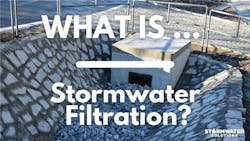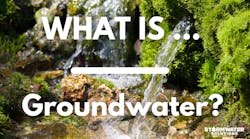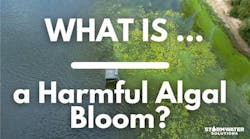What is stormwater filtration?
Stormwater filtration is the practice of treating stormwater runoff by passing it through a filtering medium to remove pollutants. Stormwater filtration systems typically capture and store runoff and then filter it through media to trap suspended solids, metals and other pollutants. The pollutants are retained by the filter media, with the primary retention mechanism being sieving. Sieving is where solids that are larger than the pore spaces in the sand and soil structure are captured and retained as the stormwater passes through the media.
Filtering media can vary and include things like:
- Sand filters: Surface, underground and perimeter sand filters.
- Vegetative filters: Grass, soil, dry swales, wet swales and filter strips.
- Organic filters: Pocket filters, submerged gravel wetlands.
Stormwater filtration also includes best management practices (BMPs) that reduce pollution in runoff. BMPs can be utilized in both built and natural environments and can be effective at removing total suspended solids (TSS), particulate phosphorus, metals and organics. BMPs include:
- Biofiltration
- Permeable pavement
- Tree trenches and tree boxes
- Dry swales and wet swales
- Sand filters
- Green roofs
How do you filter stormwater?
Filtering stormwater involves removing pollutants from runoff using various methods, including physical filtration, settling and biological processing. Common techniques for stormwater filtration include those mentioned above; sand and organic filters, permeable pavements and bioretention systems.
Physical filtration
Physical filtration involves filtering pollutants out of runoff with media and includes things like sand and organic filters and permeable pavements.
- Sand and organic filters: Utilized as settling chambers and filter beds to remove large particles and then finer particles and pollutants.
- Permeable pavements: Allows water to filter through into an underlying reservoir, promoting infiltration and filtration.
Settling
Another part of stormwater filtration is settling, or gravity separation, which slows down water allowing pollutants to settle out of water. An example of this is settling basins, where water is slowed down in a large area, allowing sediments and other heavy particles to settle. Another example is first flush vaults, which capture and store the initial runoff during a storm.
Bioretention systems
A bioretention system is a shallow, landscaped depression that uses engineered soil media, vegetation and filtration to treat runoff. The systems can capture and store stormwater, filter pollutants and allow water to infiltrate into the ground or be gradually released. Examples of bioretention systems include:
- Rain gardens
- Bioretention cells
- Bioswales
- Green roofs
- Constructed wetlands
What is the difference between infiltration and filtration of stormwater?
Stormwater infiltration and filtration are two different ways to handle runoff. Infiltration allows water to soak into the ground, while filtration allows water to pass through a porous medium before discharging or being stored.
Stormwater infiltration
Infiltration is the process where runoff seeps into the ground. It occurs through natural pours and cracks in the soil and underlying geological formations. Infiltration helps recharge groundwater, reduces runoff volume and can naturally filter pollutants.
Examples of infiltration include:
- Infiltration basins
- Infiltration trenches
- Permeable pavements
Stormwater filtration
Filtration is the process where runoff passes through a specific, engineered medium to remove pollutants. Filtration relies on the engineered medium to trap solids, remove pollutants and slow down the flow of water. It can improve water quality by removing TSS, heavy metals and other pollutants.
Examples of filtration include:
- Sand filters
- Biofiltration basins
- Tree trenches
How do storm drain filters work?
A storm drain filter is a device installed in a storm drain to collect debris and prevent larger pollutants from entering a stormwater system. They can help prevent larger pollutants from entering waterways. The filters work by trapping sediment, trash and other contaminants from runoff before it flows into the system. Filters can be installed in catch basins and as grate guards. Smaller filters can be utilized to trap smaller pollutants.
About the Author
Alex Cossin
Associate Editor
Alex Cossin is the associate editor for Waterworld Magazine, Wastewater Digest and Stormwater Solutions, which compose the Endeavor Business Media Water Group. Cossin graduated from Kent State University in 2018 with a Bachelor of Science in Journalism. Cossin can be reached at [email protected].



